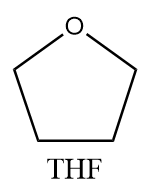
How to convert a carboxylic acid to an alcohol?
Answer
417.3k+ views
Hint: In organic chemistry, the carboxylic acids are the compound which have
Complete answer:
The reduction of carboxylic acid can be performed in many ways which are discussed as follows:
(a) Reduction by using
When carboxylic acid reacts with lithium aluminium hydride which is a strong base, then it converts into respective primary alcohol as per following reaction:

(b) Reduction by using
When carboxylic acid reacts with borane in the presence of tetrahydrofuran followed by acidic workup, then it readily converts into respective primary alcohol. The reaction proceeds as follows:

Additional Information:
Sodium borohydride i.e.,
Note:
THF is used as a solvent in most of the organic reactions because it has tendency to dissolve a wide variety of organic compounds and due to its low boiling point, it is easier to remove THF from chemical reactions via the evaporation process. The molecular structure of THF is as follows:

Complete answer:
The reduction of carboxylic acid can be performed in many ways which are discussed as follows:
(a) Reduction by using
When carboxylic acid reacts with lithium aluminium hydride which is a strong base, then it converts into respective primary alcohol as per following reaction:

(b) Reduction by using
When carboxylic acid reacts with borane in the presence of tetrahydrofuran followed by acidic workup, then it readily converts into respective primary alcohol. The reaction proceeds as follows:

Additional Information:
Sodium borohydride i.e.,
Note:
THF is used as a solvent in most of the organic reactions because it has tendency to dissolve a wide variety of organic compounds and due to its low boiling point, it is easier to remove THF from chemical reactions via the evaporation process. The molecular structure of THF is as follows:

Recently Updated Pages
Master Class 12 Business Studies: Engaging Questions & Answers for Success

Master Class 12 English: Engaging Questions & Answers for Success

Master Class 12 Social Science: Engaging Questions & Answers for Success

Master Class 12 Chemistry: Engaging Questions & Answers for Success

Class 12 Question and Answer - Your Ultimate Solutions Guide

Master Class 12 Economics: Engaging Questions & Answers for Success

Trending doubts
Give 10 examples of unisexual and bisexual flowers

Draw a labelled sketch of the human eye class 12 physics CBSE

Differentiate between homogeneous and heterogeneous class 12 chemistry CBSE

Differentiate between insitu conservation and exsitu class 12 biology CBSE

What are the major means of transport Explain each class 12 social science CBSE

Franz thinks Will they make them sing in German even class 12 english CBSE




